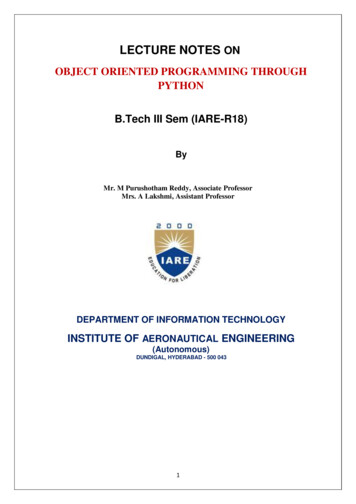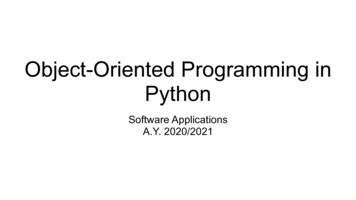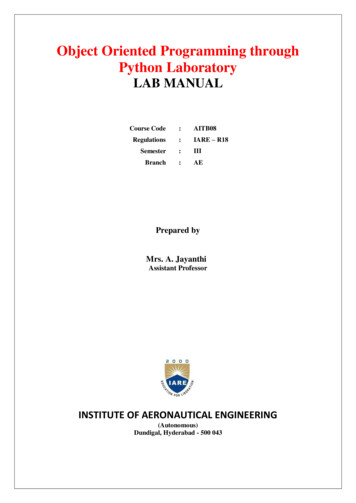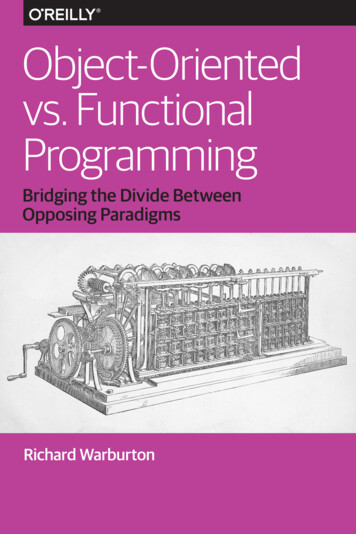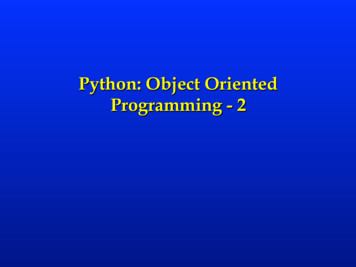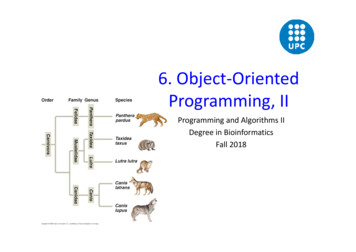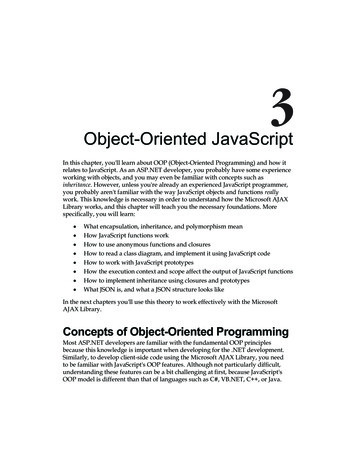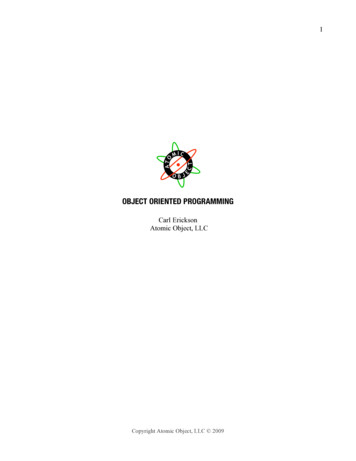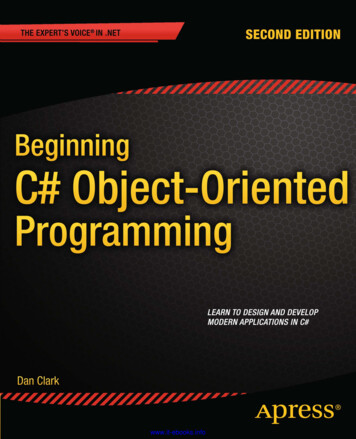
Transcription
www.it-ebooks.info
For your convenience Apress has placed some of the frontmatter material after the index. Please use the Bookmarksand Contents at a Glance links to access them.www.it-ebooks.info
Contents at a GlanceAbout the Author xviiAbout the Technical Reviewer xixAcknowledgments xxiIntroduction xxiii Chapter 1: Overview of Object-Oriented Programming 1 Chapter 2: Designing OOP Solutions: Identifying the Class Structure 7 Chapter 3: Designing OOP Solutions: Modeling the Object Interaction 25 Chapter 4: Designing OOP Solutions: A Case Study 43 Chapter 5: Introducing the .NET Framework and Visual Studio 59 Chapter 6: Creating Classes 83 Chapter 7: Creating Class Hierarchies 97 Chapter 8: Implementing Object Collaboration 119 Chapter 9: Working with Collections 143 Chapter 10: Implementing the Data Access Layer 161 Chapter 11: Developing WPF Applications 193 Chapter 12: Developing Web Applications 221 Chapter 13: Developing Windows Store Applications 251 Chapter 14: Developing and Consuming Web Services 273 Chapter 15: Developing the Office Supply Ordering Application 295 Chapter 16: Wrapping Up 321vwww.it-ebooks.info
Contents at a Glance Appendix A: Fundamental Programming Concepts 325 Appendix B: Exception Handling in C# 341 Appendix C: Installing the Required Software 347Index 353viwww.it-ebooks.info
IntroductionIt has been my experience as a .NET trainer and lead programmer that most people do not have trouble picking up thesyntax of the C# language. What perplexes and frustrates many people are the higher-level concepts of object-orientedprogramming methodology and design. To compound the problem, most introductory programming books andtraining classes skim over these concepts or, worse, don’t cover them at all. It is my hope that this book fills this void.My goals in writing this book are twofold. My first goal is to provide you with the information you need to understandthe fundamentals of programming in C#. More importantly, my second goal is to present you with the informationrequired to master the higher-level concepts of object-oriented programming methodology and design.This book provides the knowledge you need to architect an object-oriented programming solution aimed atsolving a business problem. As you work your way through the book, you will learn first how to analyze the businessrequirements of an application. Next, you will model the objects and relationships involved in the solution design.Finally, you will implement the solution using C#. Along the way, you will learn about the fundamentals of softwaredesign, the Unified Modeling Language (UML), object-oriented programming, C#, and the .NET Framework.Because this is an introductory book, it’s meant to be a starting point for your study of the topics it presents.As such, this book is not designed to make you an expert in object-oriented programming and UML; nor is it anexhaustive discussion of C# and the .NET Framework; nor is it an in-depth study of Visual Studio. It takes considerabletime and effort to become proficient in any one of these areas. It is my hope that by reading this book, your firstexperiences in object-oriented programming will be enjoyable and comprehensible—and that these experiences willinstill a desire for further study.Target AudienceThe target audience for this book is the beginning C# programmer who wants to gain a foundation in object-orientedprogramming along with C# language basics. Programmers transitioning from a procedure-oriented programmingmodel to an object-oriented model will also benefit from this book. In addition, there are many Visual Basic (VB)programmers who want to transition to C#. Before transitioning to C#, it is imperative that you understand thefundamentals of object-oriented programming.Because the experience level of a “beginner” can vary immensely, I have included a primer in Appendix A thatdiscusses some basic programming concepts and how they are implemented in C#. I would suggest you review theseconcepts if you are new to programming.Activities and Software RequirementsOne of the most important aspects of learning is doing. You can’t learn to ride a bike without jumping on a bike, andyou can’t learn to program without cranking out code. Any successful training program needs to include both a theorycomponent and a hands-on component.I have included both components throughout this book. It is my hope that you will take seriously the activitiesI have added to each chapter and work through them thoroughly—even repeatedly. Contrary to some students’perception that these activities are “exercises in typing,” the activities are where you get a chance to make the theoryxxiiiwww.it-ebooks.info
Introductionconcrete and where true simulation of the concepts occurs. I also encourage you to play as you work through anactivity. Don’t be afraid to alter some of the code just to see what happens. Some of the best learning experiencesoccur when students “color outside the lines.”The UML modeling activities in early chapters are designed for someone using UMLet. I chose this programbecause it’s a good diagramming tool to learn with. It lets you create UML diagrams without adding a lot of advancedfeatures associated with the high-end CASE tools. UMLet is a free open-source tool and can be downloaded fromwww.umlet.com. You can also use another tool such as Visio to complete the activities. However, you don’t need a toolto complete these activities; paper and pencil will work just fine.Once you begin coding, you will need Visual Studio 2012 with C# installed. I encourage you to install the helpfiles and make ample use of them while completing the activities. Chapter 13 deals with creating Windows Store Appsand requires Visual Studio installed on the Windows 8 operating system. Later chapters require Microsoft SQL Server2008 or higher with the Pubs and Northwind databases installed. Appendix C includes instructions on downloadingand installing the sample databases. You can find free Express and trial editions of both Visual Studio and SQL Serveralong with trial editions of Windows 8 at www.msdn.microsoft.com.xxivwww.it-ebooks.info
Chapter 1Overview of Object-OrientedProgrammingTo set the stage for your study of object-oriented programming (OOP) and C#, this chapter will look briefly at thehistory of object-oriented programming and the characteristics of an object-oriented programming language.You will look at why object-oriented programming has become so important in the development of industrialstrength distributed-software systems. You will also examine how C# has evolved into one of the leading applicationprogramming languages.After reading this chapter, you will be familiar with the following: what object-oriented programming is why object-oriented programming has become so important in the development of industrialstrength applications the characteristics that make a programming language object-oriented the history and evolution of C#What is OOP?Object-oriented programming is an approach to software development in which the structure of the software is basedon objects interacting with each other to accomplish a task. This interaction takes the form of messages passing backand forth between the objects. In response to a message, an object can perform an action.If you look at how you accomplish tasks in the world around you, you can see that you interact in an objectoriented world. If you want to go to the store, for example, you interact with a car object. A car object consists of otherobjects that interact with each other to accomplish the task of getting you to the store. You put the key object in theignition object and turn it. This in turn sends a message (through an electrical signal) to the starter object, whichinteracts with the engine object to start the car. As a driver, you are isolated from the logic of how the objects of thesystem work together to start the car. You just initiate the sequence of events by executing the start method of theignition object with the key. You then wait for a response (message) of success or failure.Similarly, users of software programs are isolated from the logic needed to accomplish a task. For example, whenyou print a page in your word processor, you initiate the action by clicking a print button. You are isolated from theinternal processing that needs to occur; you just wait for a response telling you if it printed. In the software program,the button object interacts with a printer object, which interacts with the actual printer to accomplish the task ofprinting the page.1www.it-ebooks.info
Chapter 1 Overview of Object-Oriented ProgrammingThe History of OOPOOP concepts started surfacing in the mid-1960s with a programming language called Simula and further evolvedin the 1970s with advent of Smalltalk. Although software developers did not overwhelmingly embrace these earlyadvances in OOP languages, object-oriented methodologies continued to evolve. In the mid-1980s there was aresurgence of interest in object-oriented methodologies. Specifically, OOP languages such as C and Eiffel becamepopular with mainstream computer programmers. OOP continued to grow in popularity in the 1990s, most notablywith the advent of Java and the huge following it attracted. And in 2002, in conjunction with the release of the .NETFramework, Microsoft introduced a new OOP language, C# (pronounced C-sharp) and revamped their widely popularexisting language, Visual Basic, so that it is now truly object-oriented. Today OOP languages continue to flourish andare a mainstay of modern programming.Why Use OOP?Why has OOP developed into such a widely used paradigm for solving business problems today? During the 1970sand 1980s, procedure-oriented programming languages such as C, Pascal, and Fortran were widely used to developbusiness-oriented software systems. Procedural languages organize the program in a linear fashion—they run fromtop to bottom. In other words, the program is a series of steps that run one after another. This type of programmingworked fine for small programs that consisted of a few hundred code lines, but as programs became larger theybecame hard to manage and debug.In an attempt to manage the ever-increasing size of the programs, structured programming was introducedto break down the code into manageable segments called functions or procedures. This was an improvement, butas programs performed more complex business functionality and interacted with other systems, the followingshortcomings of structural programming began to surface: Programs became harder to maintain. Existing functionality was hard to alter without adversely affecting all of the system’sfunctionality. New programs were essentially built from scratch. Consequently, there was little return on theinvestment of previous efforts. Programming was not conducive to team development. Programmers had to know everyaspect of how a program worked and could not isolate their efforts on one aspect of a system. It was hard to translate business models into programming models. Structural programming worked well in isolation but did not integrate well with other systems.In addition to these shortcomings, some evolutions of computing systems caused further strain on the structuralprogram approach, such as: Nonprogrammers demanded and got direct access to programs through the incorporation ofgraphical user interfaces and their desktop computers. Users demanded a more intuitive, less structured approach to interacting with programs. Computer systems evolved into a distributed model where the business logic, user interface,and backend database were loosely coupled and accessed over the Internet and intranets.2www.it-ebooks.info
Chapter 1 Overview of Object-Oriented ProgrammingAs a result, many business software developers turned to object-oriented methods and programming languages.The benefits included the following: a more intuitive transition from business-analysis models to software-implementation models the ability to maintain and implement changes in the programs more efficiently and rapidly the ability to create software systems more effectively using a team process, allowingspecialists to work on parts of the system the ability to reuse code components in other programs and purchase components written bythird-party developers to increase the functionality of existing programs with little effort better integration with loosely coupled distributed-computing systems improved integration with modern operating systems the ability to create a more intuitive graphical-user interface for the usersThe Characteristics of OOPIn this section you are going to examine some fundamental concepts and terms common to all OOP languages. Don’tworry about how these concepts get implemented in any particular programming language; that will come later. Mygoal is to familiarize you with the concepts and relate them to your everyday experiences so that they make moresense later when you look at OOP design and implementation.ObjectsAs I noted earlier, we live in an object-oriented world. You are an object. You interact with other objects. In fact,you are an object with data such as your height and hair color. You also have methods that you perform or that areperformed on you, such as eating and walking.So what are objects? In OOP terms, an object is a structure for incorporating data and the procedures for workingwith that data. For example, if you were interested in tracking data associated with product inventory, you wouldcreate a product object that is responsible for maintaining and using the data pertaining to the products. If youwanted to have printing capabilities in your application, you would work with a printer object that is responsible forthe data and methods used to interact with your printers.AbstractionWhen you interact with objects in the world, you are often only concerned with a subset of their properties. Withoutthis ability to abstract or filter out the extraneous properties of objects, you would find it hard to process the plethoraof information bombarding you and concentrate on the task at hand.As a result of abstraction, when two different people interact with the same object, they often deal with a differentsubset of attributes. When I drive my car, for example, I need to know the speed of the car and the direction it is going.Because the car is using an automatic transmission, I do not need to know the revolutions per minute (RPMs) of theengine, so I filter this information out. On the other hand, this information would be critical to a racecar driver, whowould not filter it out.When constructing objects in OOP applications, it is important to incorporate this concept of abstraction. Theobjects include only the information that is relevant in the context of the application. If you were building a shippingapplication, you would construct a product object with attributes such as size and weight. The color of the item wouldbe extraneous information and would be ignored. On the other hand, when constructing an order-entry application,the color could be important and would be included as an attribute of the product object.3www.it-ebooks.info
Chapter 1 Overview of Object-Oriented ProgrammingEncapsulationAnother important feature of OOP is encapsulation. Encapsulation is the process in which no direct access is grantedto the data; instead, it is hidden. If you want to gain access to the data, you have to interact with the object responsiblefor the data. In the previous inventory example, if you wanted to view or update information on the products, youwould have to work through the product object. To read the data, you would send the product object a message. Theproduct object would then read the value and send back a message telling you what the value is. The product objectdefines which operations can be performed on the product data. If you send a message to modify the data and theproduct object determines it is a valid request, it will perform the operation for you and send a message back withthe result.You experience encapsulation in your daily life all the time. Think about a human resources department. Theyencapsulate (hide) the information about employees. They determine how this data can be used and manipulated.Any request for the employee data or request to update the data has to be routed through them. Another exampleis network security. Any request for security information or a change to a security policy must be made through anetwork security administrator. The security data is encapsulated from the users of the network.By encapsulating data, you make the data of your system more secure and reliable. You know how the data isbeing accessed and what operations are being performed on the data. This makes program maintenance much easierand also greatly simplifies the debugging process. You can also modify the methods used to work on the data, and, ifyou do not alter how the method is requested and the type of response sent back, you do not have to alter the otherobjects using the method. Think about when you send a letter in the mail. You make a request to the post office todeliver the letter. How the post office accomplishes this is not exposed to you. If it changes the route it uses to mailthe letter, it does not affect how you initiate the sending of the letter. You do not have to know the post office’s internalprocedures used to deliver the letter.PolymorphismPolymorphism is the ability of two different objects to respond to the same request message in their own unique way.For example, I could train my dog to respond to the command bark and my bird to respond to the command chirp.On the other hand, I could train them to both respond to the command speak. Through polymorphism I know that thedog will respond with a bark and the bird will respond with a chirp.How does this relate to OOP? You can create objects that respond to the same message in their own uniqueimplementations. For example, you could send a print message to a printer object that would print the text on aprinter, and you could send the same message to a screen object that would print the text to a window on yourcomputer screen.Another good example of polymorphism is the use of words in the English language. Words have many differentmeanings, but through the context of the sentence you can deduce which meaning is intended. You know thatsomeone who says “Give me a break!” is not asking you to break his leg!In OOP you implement this type of polymorphism through a process called overloading. You can implementdifferent methods of an object that have the same name. The object can then tell which method to implement dependingon the context (in other words, the number and type of arguments passed) of the message. For example, you could createtwo methods of an inventory object to look up the price of a product. Both these methods would be named getPrice.Another object could call this method and pass either the name of the product or the product ID. The inventory objectcould tell which getPrice method to run by whether a string value or an integer value was passed with the request.InheritanceMost real-life objects can be classified into hierarchies. For example, you can classify all dogs together as having certaincommon characteristics such as having four legs and fur. Their breeds further classify them into subgroups withcommon attributes such as size and demeanor. You also classify objects according to their function. For example,there are commercial vehicles and recreational vehicles. There are trucks and passenger cars. You classify carsaccording to their make and model. To make sense of the world, you need to use object hierarchies and classifications.4www.it-ebooks.info
Chapter 1 Overview of Object-Oriented ProgrammingYou use inheritance in OOP to classify the objects in your programs according to common characteristics andfunction. This makes working with the objects easier and more intuitive. It also makes programming easier becauseit enables you to combine general characteristics into a parent object and inherit these characteristics in the childobjects. For example, you can define an employee object that defines all the general characteristics of employeesin your company. You can then define a manager object that inherits the characteristics of the employee objectbut also adds characteristics unique to managers in your company. Because of inheritance the manager object willautomatically reflect any changes to the characteristics of the employee object.AggregationAggregation is when an object consists of a composite of other objects that work together. For example, your lawnmower object is a composite of the wheel objects, the engine object, the blade object, and so on. In fact, the engineobject is a composite of many other objects. There are many examples of aggregation in the world around us. Theability to use aggregation in OOP is a powerful feature that enables you to accurately model and implement businessprocesses in your programs.The History of C#In the 1980s, most applications written to run on the Windows operating system were written in C . Even thoughC is an OOP language, it’s arguably a difficult language to master and the programmer is responsible for dealingwith housekeeping tasks such as memory management and security. These housekeeping tasks are difficult toimplement and often neglected, which results in bug-filled applications that are difficult to test and maintain.In the 1990s, the Java programming language became popular. Because it’s a managed-programming language,it runs on top of a unified set of class libraries that take care of the low-level programming tasks such as type safetychecking, memory management, and destruction of unneeded objects. This allows the programmer to concentrate onthe business logic and frees her from having to worry about the error-prone housekeeping code. As a result, programsare more compact, reliable, and easier to debug.Seeing the success of Java and the increased popularity of the Internet, Microsoft developed its own set ofmanaged-programming languages. Microsoft wanted to make it easier to develop both Windows- and Web-basedapplications. These managed languages rely on the .NET Framework to provide much of the functionality toperform the housekeeping code required in all applications. During the development of the .NET Framework, theclass libraries were written in a new language called C#. The principal designer and lead architect of C# was AndersHejlsberg. Hejlsberg was previously involved with the design of Turbo Pascal and Delphi. He leveraged this previousexperience to design an OOP language that built on the successes of these languages and improved upon theirshortcomings. Hejlsberg also incorporated syntax similar to C into the language in order to appeal to the C andJava developers. One of the goals of creating the .NET Framework and the C# language was to introduce modernconcepts such as object orientation, type safety, garbage collection, and structured-exception handling directly intothe platform.Since releasing C#, Microsoft has continually sought to add additional features and enhancements to thelanguage. For example, version 2.0 added support for generics (generics are covered in Chapter 9) and version 3.0LINQ (more about this in Chapter 10) was added to reduce the impedance mismatch between the programminglanguage and the database language used to retrieve and work with data. Today C# 5.0 includes support to makeparallel and asynchronous programming easier for developers to implement (see Chapter 8). With Microsoft’scommitment to the continual improvement and evolution of the C#, it will continue to rank as one of the most widelyused programming languages in the world.5www.it-ebooks.info
Chapter 1 Overview Of ObjeCt-Oriented prOgrammingMicrosoft is also committed to providing .NET developers with the tools necessary to have a highly productiveand intuitive programming experience. Although you can create C# programs using a text editor, most professionalprogrammers find an integrated development environment (IDE) invaluable in terms of ease of use and increasedproductivity. Microsoft has developed an exceptional IDE in Visual Studio (VS). Integrated into VS are many featuresthat make programming for the .NET Framework more intuitive (These features are covered in Chapter 5). Withthe most recent release of Visual Studio 2012, Microsoft has continued to enhance the design-time developingexperience. VS 2012 includes new features such as better debugging support for parallel programming and animproved code testing experience. As you work your way through this book, I think you will come to appreciate thepower and productivity that Visual Studio and the C# language provide.SummaryIn this chapter, you were introduced to OOP and got a brief history of C#. Now that you have an understanding of whatconstitutes an OOP language and why OOP languages are so important to enterprise-level application development,your next step is to become familiar with how OOP applications are designed.In order to meet the needs of the users, successful applications must be carefully planned and developed. Thenext chapter is the first in a series of three aimed at introducing you to some of the techniques used when designingobject-oriented applications. You will look at the process of deciding which objects need to be included in anapplication and which attributes of these objects are important to the functionality of that application.6www.it-ebooks.info
Chapter 2Designing OOP Solutions:Identifying the Class StructureMost software projects you will become involved with as a business software developer will be a team effort. As aprogrammer on the team, you will be asked to transform the design documents into the actual application code.Additionally, because the design of object-oriented programs is an iterative process, designers depend on thefeedback of the software developers to refine and modify the program design. As you gain experience in developingobject-oriented software systems, you may even be asked to sit in on the design sessions and contribute to the designprocess. Therefore, as a software developer, you should be familiar with the purpose and the structure of the variousdesign documents, as well as have some knowledge of how these documents are developed.This chapter introduces you to some of the common documents used to design the static aspects of the system.(You’ll learn how the dynamic aspects of the system are modeled in the next chapter.) To help you understand thesedocuments, this chapter includes some hands-on activities based on a limited case study. You’ll find similar activitiescorresponding to the topics of discussion in most of the chapters in this book.After reading this chapter, you will be familiar with the following: The goals of software design The fundamentals of the Unified Modeling Language The purpose of a software requirement specification How use case diagrams model the services the system will provide How class diagrams model the classes of objects that need to be developedGoals of Software DesignA well-organized approach to system design is essential when developing modern enterprise-level object-orientedprograms. The design phase is one of the most important in the software development cycle. You can trace many ofthe problems associated with failed software projects to poor upfront design and inadequate communicationbetween the system’s developers and the system’s consumers. Unfortunately, many programmers and programmanagers do not like getting involved in the design aspects of the system. They view any time not spent cranking outcode as unproductive.7www.it-ebooks.info
Chapter 2 Designing OOP Solutions: Identifying the Class StructureTo make matters worse, with the advent of “Internet time,” consumers expect increasingly shorter developmentcycles. So, to meet unrealistic timelines and project scope, developers tend to forgo or cut short the system designphase of development. This is counterproductive to the sy
The target audience for this book is the beginning C# programmer who wants to gain a foundation in object-oriented programming along with C# language basics. Programmers transitioning from a procedure-oriented programming model to an object-oriented model will also benefit from this book. In ad
